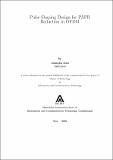Please use this identifier to cite or link to this item:
http://drsr.daiict.ac.in//handle/123456789/240| Title: | Pulse shaping design for PAPR reduction in OFDM |
| Authors: | Vijaykumar, Chakka Jain, Akansha |
| Keywords: | Orthogonal frequency division multiplexing Wireless communication systems Design Wavelength division multiplexing Orthogonalization methods Mobile communication systems Fourier transformations Computer simulation |
| Issue Date: | 2009 |
| Publisher: | Dhirubhai Ambani Institute of Information and Communication Technology |
| Citation: | Jain, Akansha (2009). Pulse shaping design for PAPR reduction in OFDM. Dhirubhai Ambani Institute of Information and Communication Technology, xii, 73 p. (Acc.No: T00203) |
| Abstract: | Future mobile communications systems reaching for ever increasing data rates require higher bandwidths than those typical used in todays cellular systems. By going to higher bandwidth the (for low bandwidth) at fading radio channel becomes frequency selective and time dispersive. Due to its inherent robustness against time dispersion Orthogonal Frequency Division Multiplex (OFDM) is an attractive candidate for such future mobile communication systems. OFDM partitions he available bandwidth into many subchannels with much lower bandwidth. Such a narrowband subchannel experiences now almost at fading channel. However, one potential drawback with OFDM modulation is the high Peak to Average power Ratio (PAPR) of the transmitted signal: The signal transmitted by the OFDM system is the superposition of all signals transmitted in the narrowband subchannels. The transmit signal has then due to the central limit theorem a Gaussian distribution leading to high peak values compared to the average power. system design not taking this into account will have a high clip rate. Each signal sample that is beyond the saturation limit of the power amplier suersither clipping to this limit value or other non- linear distortion, both creating additional bit errors in the receiver. One possibility to avoid clipping is to design he system for very high signal peaks. However, this approach leads to very high power consumption (since the power amplifier must have high supply rails) and also complex power amplifiers. The preferred solution is therefore to apply digital signal processing that reduces such high peak values in the transmitted signal thus voiding clipping. These methods are commonly referred to as PAPR reduction. APR reduction methods can be categorized into transparent methods here the receiver is not aware of the reduction scheme applied by the transmitter and on-transparent methods where the receiver needs to know the PAPR algorithm applied by the transmitter. This master thesis would focus on transparent PAPR reduction algorithms. The pulse shaping mechanism is used to reduce PAPR. he ct is analyzed in terms of BER. |
| URI: | http://drsr.daiict.ac.in/handle/123456789/240 |
| Appears in Collections: | M Tech Dissertations |
Files in This Item:
| File | Description | Size | Format | |
|---|---|---|---|---|
| 200711010.pdf Restricted Access | 1.85 MB | Adobe PDF |  View/Open Request a copy |
Items in DSpace are protected by copyright, with all rights reserved, unless otherwise indicated.
